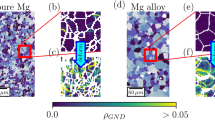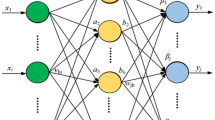Abstract
Background
Microstructural features such as grain boundaries play a significant role in the macroscopic plastic response of polycrystalline metals. However, a quantitative link between plastic strain accumulation at grain boundaries and material response in plasticity dominated phenomena is still lacking.
Objective
Here we seek to develop predictive relations between a material’s granular microstructure and the accumulation of plastic strains at the microstructural level during plastic deformation.
Methods
A single-input neural network approach was applied to predict the residual plastic strain fields at regions surrounding grain boundaries of an austenitic stainless steel. The neural network was trained on data obtained by applying a very-high resolution digital image correlation (DIC) experimental technique that allows the measurement of grain-scale strains aligned to the underlying microstructure obtained from electron backscatter diffraction (EBSD) scans.
Results
The neural-network-predicted and the DIC-measured strain fields showed good correlation for most of the tested cases. Best individual agreement was found when each microstructure was used to predict fields in its own case. However, best overall average predictions were seen when multiple samples were used for the network training.
Conclusions
The results showed that the local geometrical angle between a grain boundary and the loading axes is in many cases a good predictor for the accumulation of strains at the given boundary. The expected limitations of this single parameter approach (grain boundary angle alone cannot be a good predictor for varying strains along a straight grain boundary, for example) were seen as the reason for the situations where predictions were not as good.













Similar content being viewed by others
References
Eshelby J, Frank F, Nabarro F (1951) The equilibrium of linear arrays of dislocations. Philos Mag 42:351–364
Petch NJ (1953) The cleavage strength of polycrystals. J Iron Steel Inst 174:25–28
Hall E (1951) The deformation and aging of mild steel:III. Discussion of results. Proc Phys Soc Lond 38(10):747–753
Sutton AP, Balluffi RW (2006) Interfaces in crystalline materials. Oxford University Press, Oxford
Lee TC, Robertson IM, Birnbaum H (1989) Prediction of slip transfer mechanisms across grain boundaries. Scr Metall 23(5):799
Jin ZH, Gumbsch P (2008) Interactions between non-screw lattice dislocations and coherent twin boundaries in face-centered cubic metals. Acta Mater 56(5):1126
Abuzaid W, Sangid M, Carroll J, Sehitoglu H (2012) Slip transfer and plastic strain accumulation across grain boundaries in Hastelloy X. J Mech Phys Solids 60(6):1201–1220
Abuzaid W, Sehitoglu H, Lambros J (2013) Plastic strain localization and fatigue micro-crack formation in Hastelloy X. Mater Sci Eng A 561:507–519
Figueroa J, Laird C (1983) Crack initiation mechanisms in copper polycrystals cycled under constant strain amplitudes and in step tests. Mater Sci Eng 60(1):45–58
Chan K (2010) Roles of microstructure in fatigue crack initiation. Int J Fatigue 32(9):1428–1447
Carroll J, Abuzaid W, Lambros J, Sehitoglu H (2013) On the interactions between strain accumulation, microstructure, and fatigue crack behavior. Int J Fract 180:223–241
Littlewood P, Wilkinson A (2014) Local deformation patterns in Ti-6Al-4V under tensile, fatigue and dwell fatigue loading. Int J Fatigue 43:111–119
Gurney K (1997) An introduction to neural networks. UCL Press, London
McCulloch W, Pitts W (1943) A logical calculus of the ideas immanent in nervous activity. Math Biophysics 7:115–133
Sourmail T, Bhadeshia H, MacKay D (2002) Neural network model of creep strength of austenitic stainless steels. Mater Sci Technol 18:655–663
Lee D, Hong S, Cho S, Joo W (2005) A study on fatigue damage modeling using neural networks. J Mech Sci Technol 19(7):1393–1404
Kang J, Choi B, Lee H, Kim J, Kim K (2006) Neural network application in fatigue damage analysis under multiaxial random loadings. Int J Fatigue 28(2):132–140
Pujol J, Pinto J (2011) A neural network approach to fatigue life prediction. Int J Fatigue 33(3):313–322
Martinez M, Ponce M (2019) Fatigue damage effect approach by artificial neural network. Int J Fatigue 124:42–47
Mozaffar M, Bostanabad R, Chen W, Ehman K, Cao J, Bessa MA (2019) Deep learning predicts path-dependent plasticity. Proc Natl Acad Sci USA 116(52):26414–26420. https://doi.org/10.1073/pnas.1911815116
Lin Y, Zhang J, Zhong J (2008) Application of neural networks to predict the elevated temperature. Comput Mater Sci 43(4):752–758
Li H-Y, Wang X-F, Wei D-D, Hu J-D, Li Y-H (2012) A comparative study on modified zerilli–Armstrong, arrhenius-type and artificial neural network models to predict high-temperature deformation behavior in t24 steel. Mater Sci Eng 536:216–222
Jones R, Templeton J, Sanders C, Ostien J (2018) Machine learning models of plastic flow based on representation theory. Comput Model Eng Sci 117:309–342
Carroll J, Abuzaid W, Lambros J, Sehitoglu H (2010) An experimental methodology to relate local strain to microstructural texture. Rev Sci Instrum 81(8):083703
Swati U, Li H, Bowen P, Rabiei A (2018) A study on tensile properties of alloy 709 at various temperatures. Mater Sci Eng A 733:338–349
Naoi H, Mimura H, Ohgami M, Sakakibara M, Araki S, Sogoh Y, Ogawa T, Sakurai H, Fujita T (1993) Development of tubes and pipes for ultra-supercritical thermal power plant boilers. Nippon Steel Tech Rep 57:22–27
Ding R, Yan J, Li H, Yu S, Rabiei A, Bowen P (2019) Deformation microstructure and tensile properties of alloy 709 at different temperatures. Mater Des 176
Sourmail T, Bhadeshia H (2005) Microstructural evolution in two variants of NF709 at 1023 and 1073 K. Metall Mater Trans A 36(1):23–34
Lall A, Sarkar S, Ding R, Bowen P, Rabiei A (2019) Performance of alloy 709 under creep-fatigue at various dwell times. Mater Sci Eng A 761:138028
Shaber N, Stephens R, Ramirez J, Potirniche G, Taylor M, Charit I, Pugesek H (2019) Fatigue and creep-fatigue crack growth in alloy 709 at elevated temperatures. Mater High Temp 36(6):562–574
Sutton M, Wolters W, Peters W, Ranson W, McNeill S (1983) Determination of displacements using an improved digital correlation method. Image Vis Comput 1(3):133–139
Schindelin J, Arganda-Carreras I, Frise E, Kaynig V, Longair M, Pietzsch T, Preibisch S, Rueden C, Saalfeld S, Schmid B, Tinevez J, White DJ, Hartenstein V, Eliceiri K, Tomancak P, Cardona A (2012) Fiji: an open-source platform for biological-image analysis. Nat Methods 9(7):676–682
Wilkinson A, Britton T (2012) Strains, planes, and EBSD in materials science. Mater Today 15(9):366–376
Meyers MAE (1982) Model for the effect of grain size on the yield stress of metals. Philos Mag A 46(5):737–759
Marquardt D (1963) An algorithm for least-squares estimation of nonlinear parameters. SIAM J Appl Math 11(2):431–441
MathWorks, (2020). Deep Learning Toolbox: User’s Guide (R2020b). Retrieved October 22, 2020 from https://www.mathworks.com/help/pdf_doc/deeplearning/nnet_ug.pdf
Acknowledgements
This research was performed in part using funding received from the Department of Energy Office of Nuclear Energy’s Nuclear Energy University Program under grant number DE-NE0008436 (Project number 15-8432). The work was carried out in part in the Materials Research Laboratory Central Research Facilities University of Illinois (EBSD measurements), and the Advanced Materials Testing and Evaluation Laboratory University of Illinois (mechanical testing).
Author information
Authors and Affiliations
Corresponding author
Ethics declarations
Conflict of Interest
The authors declare that they have no conflict of interest.
Additional information
Publisher’s Note
Springer Nature remains neutral with regard to jurisdictional claims in published maps and institutional affiliations.
Rights and permissions
About this article
Cite this article
Vieira, R.B., Lambros, J. Machine Learning Neural-Network Predictions for Grain-Boundary Strain Accumulation in a Polycrystalline Metal. Exp Mech 61, 627–639 (2021). https://doi.org/10.1007/s11340-020-00687-1
Received:
Accepted:
Published:
Issue Date:
DOI: https://doi.org/10.1007/s11340-020-00687-1




